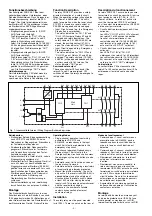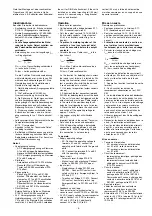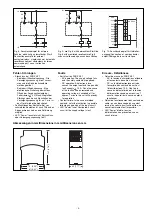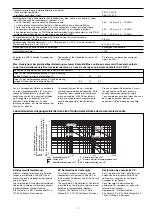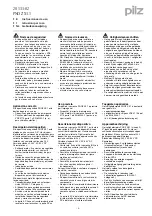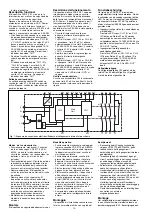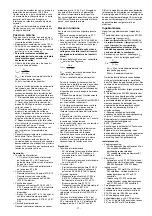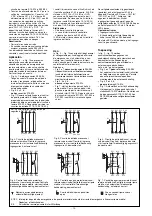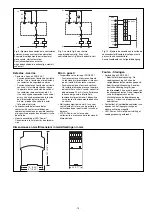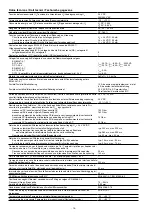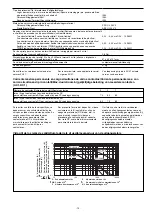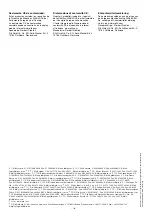
- 3 -
Gerät bei Montage auf einer senkrechten
Tragschiene (35 mm) durch ein Halte-
element wie z. B. Endhalter oder Endwinkel.
vertical (35 mm) à l'aide d'un élément de
maintien comme par ex. un support ou une
équerre terminale.
the unit for DIN-Rail attachment. If the unit is
installed on a vertical mounting rail (35 mm),
ensure it is secured using a fixing bracket
such as end bracket.
Inbetriebnahme
Beachten Sie bei der Inbetriebnahme:
• Auslieferungszustand: Brücke zwischen
S11-S12 (Eingangskreis zweikanalig)
• Nur die Ausgangskontakte 13-14/23-24/33-
34 sind Sicherheitskontakte. Ausgangs-
kontakt 41-42 ist ein Hilfskontakt (z. B. für
Anzeige).
• Vor die Ausgangskontakte eine Siche-
rung (siehe techn. Daten) schalten, um
das Verschweißen der Kontakte zu
verhindern.
• Berechnung der max. Leitungslänge I
max
im Eingangskreis:
R
lmax
R
l
/ km
I
max
=
R
lmax
= max. Gesamtleitungswiderstand
(s. technische Daten)
R
l
/km = Leitungswiderstand/km
Da die Funktion Querschlusserkennung
nicht einfehlersicher ist, wird sie von Pilz
während der Endkontrolle geprüft. Eine
Überprüfung nach der Installation des
Geräts ist wie folgt möglich:
1. Gerät betriebsbereit (Ausgangskontakte
geschlossen)
2. Die Testklemmen S22/S32 zur
Querschlussprüfung kurzschließen.
3. Die Sicherung im Gerät muss auslösen
und die Ausgangskontakte öffnen.
Leitungslängen in der Größenordnung der
Maximallänge können das Auslösen der
Sicherung um bis zu 2 Minuten verzögern.
4. Sicherung wieder zurücksetzen: den
Kurzschluss entfernen und die Versor-
gungsspannung für ca. 1 Minute abschal-
ten.
• Leitungsmaterial aus Kupferdraht mit einer
Temperaturbeständigkeit von
60/75 °C verwenden.
• Angaben im Kapitel „Technische Daten“
unbedingt einhalten.
• Bei Betrieb mit Wechselspannung ist eine
lösbare Verbindung zwischen Gerät und
Betriebserde erforderlich. Der Anschluss
entfällt bei Gleichspannung.
Ablauf:
• Versorgungsspannung:
- AC: Versorgungsspannung an Klemmen
A1 und A2 anlegen; Betriebserdungs-
klemme mit Schutzleitersystem verbinden
- DC: Versorgungsspannung an Klemmen
B1 und B2 anlegen
• Startkreis:
- Automatischer Start: S13-S14 brücken.
- Manueller Start mit Überwachung:
Taster an S33-S34 anschließen (S13-
S14 offen)
• Eingangskreis:
- Einkanalig: S21-S22 und S31-S32
brücken. Öffnerkontakt von Auslöse-
element an S11 und S12 anschließen.
- Zweikanalig: S11-S12 brücken.
Öffnerkontakt von Auslöseelement an
S21-S22 und S31-S32 anschließen.
• Rückführkreis:
Externe Schütze in Reihe zu Startkreis
S13-S14 bzw. S33-S34 anschließen.
• 24 V Versorgungsspannung für
Halbleiterausgang: +24 V DC an Klemme
Y31 und 0 V an Klemme B2 anschließen,
zusätzlich 0 V der SPS mit B2 verbinden
Operation
Please note for operation:
• Unit delivered with a bridge between S11-
S12 (2-channel input circuit)
• Only the output contacts 13-14/23-24/33-
34 are safety contacts. Output contact
41-42 is an auxiliary contact (e.g. for a
display).
• To prevent a welding together of the
contacts, a fuse (see technical data)
must be connected before the output
contacts.
• Calculate the max. Cable runs I
max
in the
input circuit:
R
lmax
R
l
/ km
I
max
=
R
lmax
= Max. Total cable resistance (see
technical details)
R
l
/km = Cable resistance/km
As the function for detecting shorts across
the inputs is not failsafe, it is tested by Pilz
during the final control check. However, a
test is possible after installing the unit and
it can be carried out as follows:
1. Unit ready for operation (output contacts
closed)
2. Short circuit the test (connection) terminals
S22/S32 for detecting shorts across the inputs
3. The unit‘s fuse must be triggered and the
output contacts must open. Cable lengths
in the scale of the maximum length can
delay the fuse triggering for up to 2 minutes.
4. Reset the fuse: remove the short circuit
and switch off the operating voltage for
approx. 1 minute.
• Use copper wiring that will withstand
60/75 °C
• Important details in the section "Technical
Data“ should be noted and adhered to.
• With AC operating voltage a detachable
connection is required between unit and
system earth. With DC operating voltage
this connection is not necessary.
To operate:
• Supply operating voltage
- AC: Connect the operating voltage to
terminals A1 and A2; connect the
operating earth terminal with the ground
earth.
- DC: Connect the terminals B1 and B2
with the operating voltage.
• Reset circuit:
- Automatic reset: Bridge S13-S14
- Manual reset with monitoring: Connect
button to S33-S34 (S13-S14 open).
• Input circuit:
- Single-channel: Bridge S21-S22 and
S31-S32. Connect N/C contact from
safety switch (e.g. Emergency-Stop) to
S12 and S11.
- Two-channel: Bridge S11-S12. Connect
N/C contact from safety switch (e.g.
Emergency-Stop) to S21-S22 and S31-
S32.
• Feedback control loop:
Connect external relays/contactors in
series to reset circuit S13-S14 or S33-S34
• 24 VDC supply voltage for semi-conductor
output: C24 V DC to terminals
Y31 and 0 V DC to B2, additionally
connect 0 V of the PLC to B2.
Mise en oeuvre
Remarques préliminaires :
• Pontages présents à la livraison: S11-
S12 (commande par 2 canaux)
• Seuls les contacts 13-14, 23-24, 33-34
sont des contacts de sécurité. Le contact
41-42 est un contact d’information (ex.
voyant)
• Protection de contacts de sortie par
des fusibles (voir caractéristiques
techniques) pour éviter leur soudage
• Calcular les longueurs de câblage max
I
max
dans le circuit d’entrée:
R
lmax
R
l
/ km
I
max
=
R
lmax
= résistivité de câblage totale max.
(voir les caractéristiques techniques)
R
l
/km = résistivité de câblage/km
La fonction de détection de court-circuit
est testé par Pilz lors du contrôle final. Un
test sur site est possible de la façon
suivante :
1. Appareil en fonction (contacts de sortie
fermés)
2. Court-circuiter les bornes de
raccordement nécessaires au test S22/
S32
3. Le fusible interne du relais doit déclencher
et les contacts de sortie doivent s‘ouvrir.
Le temps de réponse du fuisible peut aller
jusqu‘à 2 min. si les longueurs de câblage
sont proches des valeurs maximales.
4. Réarmement du fusible : enlever le
court-circuit et couper l‘alimentation du
relais pendant au moins 1 min.
• Utiliser uniquement des fils de cablâge en
cuivre 60/75 °C.
• Respecter les données indiquées dans le
chap. „Caractéristiques techniques“.
• Pour les tensions d'alimentation alternati-
ves UB~, une liaison amovible entre le
boîtier et la terre est exigée. Cette liaison
n'est pas nécessaire pour les relais
alimentés en 24 V DC.
Mise en oeuvre :
• Tension d’alimentation
- AC: amener la tension d’alimentation
sur A1 et A2; relier la borne terre
- DC: amener la tension d’alimentation
sur B1 et B2
• Circuit de réarmement:
- réarmement automatique: pontage des
bornes S13-S14
- réarmement manuel auto-côntrolé:
câblage d'un poussoir sur S33-S34
(S13-S14 ouvert).
• Circuits d’entrée:
- Commande par 1 canal : câblage du
contact à ouverture entre S11-S12,
pontage entre S21-S22 et S31-S32
- Commande par 2 canaux: câblage des
contacts à ouverture entre S21-S22 et
S31-S32, pontage entre S11-S12
• Boucle de retour:
câbler les contacts des contacteurs
externes en série dans le circuit de
réarmement S13-S14 ou S33-S34
• Alimentation 24 V DC de la sortie statique:
relier le +24 V DC à la borne Y31 et le 0 V
à la borne B2, relier également le 0 V de
l'API à B2.


